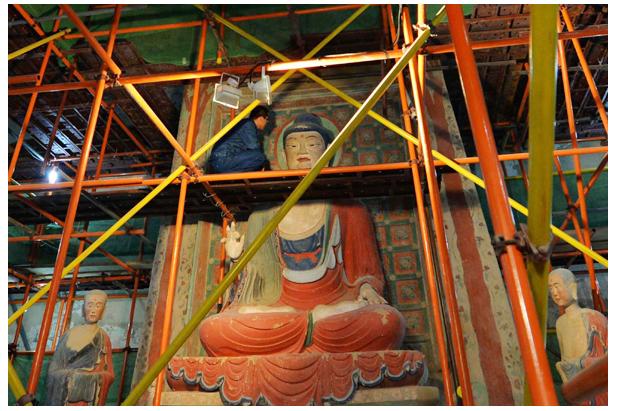| Home > China Feature |
Celebriting 70 years' efforts in restoring Mogao Grottoes artwork

Work is being carried out at the restoration site of cave No 98 at the Mogao Grottoes in Gansu province. More than 5,000 square meters of cracked, flaked, faded and detached murals have been successfully restored in the past 70 years.
Deep within a network of caves lining the Dunhuang oasis in Gansu province, thousands of 1,600-year-old Buddhist sculptures sit in silent decay.
The Mogao Grottoes collection of Buddhist artworks, which occupies the caves in a 1,700-meter cliff, is considered one of the finest in existence. It was listed as a World Heritage Site in 1987.
With most of the frescoes and sculptures dating to 400 AD, hundreds of years spent in the damp confines of the caves have taken their toll on the precious works, says Wang Xudong, deputy director of the Dunhuang Research Academy.
The restoration of these relics is the proudest achievement of the academy, which celebrates its 70th anniversary this month.
Wang and his colleagues have spent decades countering the effects of erosion, and their dedicated work on this ancient 5,000-square-meter site continues.
Since its establishment in 1944, the academy has devoted its time and resources to repairing and restoring the antique wall paintings in the grottoes.
Located in nearby Dunhuang, the academy boasts a team of highly skilled specialists who have spent the past few years photographing the frescoes in the hope that even if the Buddhist art eventually falls into decay, digital images will last for centuries to come.
Using modern technology, a process has been devised to "cure" the cracked, flaked, faded and detached murals.
Wang says the goal is to prolong the life of the world cultural heritage site indefinitely.
Known as the Thousand Buddha Caves, the Mogao Grottoes consist of 735 caves, with the ancient Buddhist frescos covering a combined area of 45,000 square meters. The paintings are considered among the best preserved in the world.
Since the 1980s, the academy has joined with relic protection institutions worldwide in exploring mural restoration technologies and cultivating skills to help preserve the site.
In 2009, the National Engineering Research Center for Conservation of Ancient Wall Paintings was set up at the academy to serve as a State-level engineering center on ancient mural restoration for both the Mogao Grottoes and other ancient murals around the country.
Of China's 38 sites on the World Heritage List, 11 have ancient murals.
Art
 more
moreChina Beijing International Diet ...
Recently, The hit CCTV documentary, A Bite of China, shown at 10:40 ...

Exhibition of Ancient Chinese Jad...
At least 8,000 years ago, Chinese ancestors discovered a beautiful...

Longmen Grottoes
The Longmen Grottoes, located near Luoyang, Henan Province, are a tr...

Custom
 more
moreWeb Dictionary
Martial Arts
Tai Chi Master Class Held in Moscow
MOSCOW, June 15, 2016 (Xinhua) -- Students learn from Shaolin ...
Celebriting 70 years' efforts in restoring Mogao...
Work is being carried out at the restoration site of cave No 98 a...
Hong Kong Children's Symphony performs in Seattle
Under the theme of Tribute to the Golden Age, a concert featuring a ...





 print
print  email
email  Favorite
Favorite  Transtlate
Transtlate 








